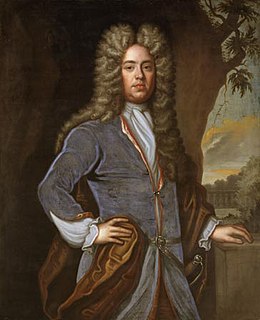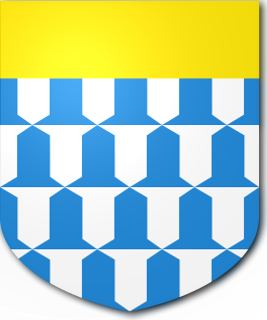The topic of this article may not meet Wikipedia's notability guideline for biographies .(December 2021) |
Sir John Aubrey, 1st Baronet (c. 1606 - c. March 1679) [1] of Llantrithyd, Glamorgan was an English landowner.
The topic of this article may not meet Wikipedia's notability guideline for biographies .(December 2021) |
Sir John Aubrey, 1st Baronet (c. 1606 - c. March 1679) [1] of Llantrithyd, Glamorgan was an English landowner.
He was the son of Sir Thomas Aubrey and Mary Mansell. He matriculated at Wadham College, Oxford on 3 November 1626, at the age of 20. He was created 1st Baronet Aubrey, of Llantrithyd, Glamorgan on 23 July 1660. [1] He died in about March 1679 and was buried at Llantrithyd in Glamorgan, Wales on 25 March 1679.
At some time before 1650 he married Mary South (d.1680 [2] ), by whom he had issue:
There have been 18 baronetcies created for persons with the surname Campbell, six in the Baronetage of Nova Scotia and twelve in the Baronetage of the United Kingdom.

The Aubrey Baronetcy, of Llantrithyd in the County of Glamorgan, was a title in the Baronetage of England. It was created on 23 July 1660 for John Aubrey. The second Baronet sat as Member of Parliament for Brackley. The third Baronet represented Cardiff. The sixth Baronet represented six different constituencies in Parliament. The title became extinct on the death of the seventh Baronet in 1856.
There have been five baronetcies created for persons with the surname Clarke, two in the Baronetage of England and three in the Baronetage of the United Kingdom. Two of the creations are extant as of 2010.

Baron Mansel, of Margam in the County of Glamorgan, was a title in the Peerage of Great Britain. It was created on 1 January 1712 for Sir Thomas Mansel, 5th Baronet, previously Member of Parliament for Cardiff and Glamorganshire. His ancestor had been created a Baronet, of Margam in the County of Glamorgan, in the Baronetage of England on 22 May 1611. The fourth Baronet represented Glamorgan in the House of Commons. The fourth Baron sat as Member of Parliament for Cardiff. On his death 29 November 1750 the barony and baronetcy became extinct.
Nineteen baronetcies have been created for persons with the surname Hamilton, eight in the Baronetage of Nova Scotia, one in the Baronetage of England, five in the Baronetage of Ireland, one in the Baronetage of Great Britain and four in the Baronetage of the United Kingdom. As of 2008 two creations are extant, two are dormant, two are either extinct or dormant and twelve extinct.
The Fletcher, later Aubrey-Fletcher Baronetcy, of Clea Hall in the County of Cumberland, is a title in the Baronetage of Great Britain. It was created on 20 May 1782 for Henry Fletcher, a Director of the Honourable East India Company and Member of Parliament. He was a descendant of Philip Fletcher, whose brother Sir Richard Fletcher was the father of Sir Henry Fletcher, 1st Baronet, of Hutton in le Forest. Fletcher was succeeded by his son, Henry, the second Baronet. He was High Sheriff of Cumberland from 1810 to 1811. His grandson, the fourth Baronet, was a prominent Conservative politician. In 1903 he assumed by Royal licence the additional surname of Aubrey on inheriting the Aubrey estates on the death of Charles Aubrey. Aubrey-Fletcher died childless and was succeeded by his younger brother, Lancelot, the fifth Baronet. He assumed by Royal licence the additional surname of Aubrey on succeeding to the title in 1910. His eldest surviving son, Henry, the sixth Baronet, was Lord-Lieutenant of Buckinghamshire from 1954 to 1961. He was succeeded by his son, John, the seventh Baronet. He was High Sheriff of Buckinghamshire in 1961. As of 2008 the title is held by his son, Henry, the eighth Baronet, who succeeded in 1992. He is Lord-Lieutenant of Buckinghamshire since 2006.

Sir John Aubrey, 6th Baronet was a British Tory politician. In 1786, he succeeded to his father's baronetcy.

Sir John Aubrey, 3rd Baronet, of Llantriddyd, Glamorgan, and Boarstall, Buckinghamshire, was a British Whig politician who sat in the English House of Commons from 1706 to 1707, and then in the British House of Commons from 1707 to 1710.
Sir John Aubrey, 2nd Baronet was an English politician.
There have been eight baronetcies created for persons with the surname Graham, two in the Baronetage of Nova Scotia, two in the Baronetage of England, one in the Baronetage of Great Britain and three in the Baronetage of the United Kingdom.
There have been seven baronetcies created for persons with the surname Lawrence, one in the Baronetage of England, one in the Baronetage of Great Britain and five in the Baronetage of the United Kingdom.
There have been six baronetcies created for persons with the surname Thomas, three in the Baronetage of England, one in the Baronetage of Great Britain and two in the Baronetage of the United Kingdom. Two of the creations are extant as of 2016.
This page is a list of High Sheriffs of Glamorgan. Sheriffs of Glamorgan served under and were answerable to the independent Lords of Glamorgan until that lordship was merged into the crown. This is in contrast to sheriffs of the English shires who were from the earliest times officers of the crown. Sheriffs in the modern sense, appointed and answerable to the crown, were instituted in the county of Glamorgan in 1541.
Three baronetcies were created for different families bearing the name of Halford, but related to one another. The first baronetcy was created in 1641 for Richard Halford in the Baronetage of England. It became extinct in 1780 with the death of the seventh and last baronet. The second baronetcy was created in 1706, also in the Baronetage of England, but became extinct in 1720 in the second generation. The third and last baronetcy was created in 1809 in the Baronetage of the United Kingdom for a prominent physician descended maternally from the fifth Baronet of the previous creation. It too became extinct with the death of the fourth Baronet in 1897.

There have been two baronetcies created for persons with the surname Tichborne, both in the Baronetage of England. Both creations are extinct.
There have been two Wray Baronetcies, both created in the Baronetage of England. The first was created on 25 November 1611 for William Wray of Glentworth, Lincolnshire, and became extinct upon the death of the 15th Baronet in 1809. The second was created on 27 June 1660 for William Wray of Ashby, Lincolnshire. He was the grandson of the 1st Baronet of Glentworth, and his son, Christopher Wray, inherited the 1660 baronetcy in 1669 and the 1611 baronetcy, as the 6th Baronet, in 1672. The 1660 creation became extinct upon the death of Sir William Wray, 7th Baronet of Glentworth and 2nd Baronet of Ashby, in about 1687.
Edmund Thomas (1633–1677) was a Welsh politician who sat in the House of Commons in 1654 and 1656 and sat in Cromwell's Upper House. He supported the Parliamentary cause during the English Civil War and the Interregnum.
Sir Robert Thomas, 2nd Baronet (c.1622-1685) was a Welsh politician who sat in the House of Commons of England from 1661 to 1681. He was knighted and succeeded as baronet in 1673 on the death of his father.
Llantrithyd is a rural village and community in the Vale of Glamorgan, Wales. The Aubrey Baronets were lords of the manor of Llantrithyd for centuries: the family died out in the 1850s.

The Abdy baronetcy, of Felix Hall, in the County of Essex, was created in the Baronetage of England on 14 July 1641 for Thomas Abdy who was High Sheriff of Essex. The title became extinct in 1868.
{{cite web}}: CS1 maint: unfit URL (link)